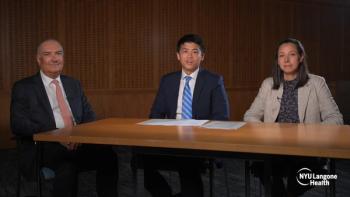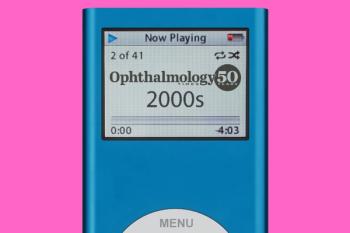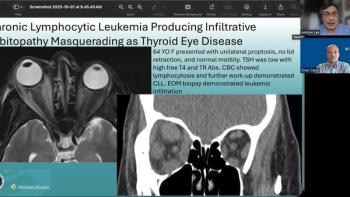
- Ophthalmology Times: January 2021
- Volume 46
- Issue 1
Anti-VEGF medications may cause systemic complications in ROP
Investigators examine long-term effects of therapeutics in infants.
This article was reviewed by Kamiar Mireskandari, PhD, MBCHB, FRCSEd, FRCOphth
Anti-VEGF drugs are being used with increasing frequency for treatment of retinopathy of prematurity (ROP) in an off-label capacity, and they have been reported to be effective.1,2
However, concerns exist about the absorption of these drugs resulting in systemic complications in babies with ROP, according to Kamiar Mireskandari, PhD, MBCHB, FRCSEd, FRCOphth.
Related:
Mireskandari is the John and Melinda Thompson Chair in Vision Research at The Hospital for Sick Children, which is affiliated with the University of Toronto in Ontario.
Evidence supports the effects of systemic absorption of anti-VEGF drugs. Intravitreally injected bevacizumab (Avastin, Genentech) is systemically absorbed and causes a reduction of VEGF in serum levels for about 8 weeks.3
The same investigators also conducted a study in which they compared aflibercept (Eylea, Regeneron Pharmaceuticals) with bevacizumab and reported that both drugs reduced the serum levels of VEGF for 12 weeks.4
In contrast, the RAINBOW study (NCT02375971) reported that ranibizumab (Lucentis, Genentech), even at high doses, does not have a significant effect on serum VEGF levels. 2
Related:
Relevance of decreased VEGF
Despite its relative isolation, the eye is connected to the rest of the body. When the VEGF in the vitreous decreases in response to treatment, so does the VEGF in the serum.
“The retina, the organ most affected by intravitreal injections, goes on to vascularize and function well,” Mireskandari said. “Why are remote bodily tissues affected by a relatively small change?”
To find out, he and his colleagues used a rat model in which rat pups were given a high dose of anti-VEGF, weighed for 14 days, and then killed on the last day to examine the organs.
Mireskandari reported that the anti-VEGF antibody was present in the systemic circulation 2 weeks after the injection. Evaluation of the whole body indicated that 1 anti-VEGF injection did not significantly affect the weights of the body, brain, lungs, liver, or kidneys.
Related:
However, the injection caused cardiac hypertrophy and pulmonary hypertension. The investigators also found the mRNA expression for VEGF was elevated in the lung and kidney but not the brain or liver.5
“These findings indicate that even though the whole body and organ weights did not change markedly as the result of the systemic VEGF levels at 14 days at the molecular levels, there was a signaling change for the lung and kidney, [which possibly affected] these organs,” Mireskandari explained. “It is important to note that pulmonary hypertension is a potential problem and that there were no effects on the liver and brain.”
The long-term systemic effects of VEGF are important to consider. Bronchopulmonary dysplasia is a problem in premature babies and may be affected by injection of bevacizumab.
Related:
In the BEAT-ROP study (NCT00622726), 5 deaths occurred among the babies who received bevacizumab due to respiratory issues compared with the death of 2 babies treated with laser thereapy.1
In the kidney, glomerular filtration is VEGF-dependent and may be a factor over time. The effects of VEGF on the brain and liver are inconclusive and require more study, Mireskandari concluded.
--
Kamiar Mireskandari, PhD, MBCHB, FRCSEd, FRCOphth
e:[email protected]
Mireskandari is a consultant to Santen Canada and AbbVie. Use of anti-VEGF agents is off-label in ROP.
--
References
1. Bevacizumab eliminates the angiogenic threat of retinopathy of prematurity (BEAT-ROP). ClinicalTrials.gov. Updated June 6, 2017. https://clinicaltrials.gov/ct2/show/NCT00622726?term=BEAT-ROP&draw=2&rank=1
2. Stahl A, Lepore D, Fielder A, et al. Ranibizumab versus laser therapy for the treatment of very low birthweight infants with retinopathy of prematurity (RAINBOW): an open-label randomised controlled trial. Lancet. 2019;394(10208):1551-1559. doi:10.1016/S0140-6736(19)31344-3
3. Wu WC, Lien R, Liao PJ, et al. Serum levels of vascular endothelial growth factor and related factors after intravitreous bevacizumab injection for retinopathy of prematurity. JAMA Ophthalmol. 2015;133(4):391-397. doi:10.1001/jamaophthalmol.2014.5373
4. Huang CY, Lien R, Wang NK, et al. Changes in systemic vascular endothelial growth factor levels after intravitreal injection of aflibercept in infants with retinopathy of prematurity. Graefes Arch Clin Exp Ophthalmol. 2018;256(3):479-487. doi:10.1007/s00417-017-3878-4
5. Khalili S, Shifrin Y, Pan J, Belik J, Mireskandari K. The effect of a single anti-vascular endothelial growth factor injection on neonatal growth and organ development: in-vivo study. Exp Eye Res. 2018;169:54-59. doi:10.1016/j.exer.2018.01.020
Articles in this issue
over 4 years ago
Research is unfolding the proteins in retinitis pigmentosaover 4 years ago
Physicians discuss advancements in the treatment of wet AMDover 4 years ago
Developments in glaucoma offering hope, optionsover 4 years ago
Transscleral laser therapy device simplifies procedureover 4 years ago
It takes a village to beat visual system diseases in childrenover 4 years ago
The value of new diagnostics and personalized medicineNewsletter
Don’t miss out—get Ophthalmology Times updates on the latest clinical advancements and expert interviews, straight to your inbox.





















































.png)


